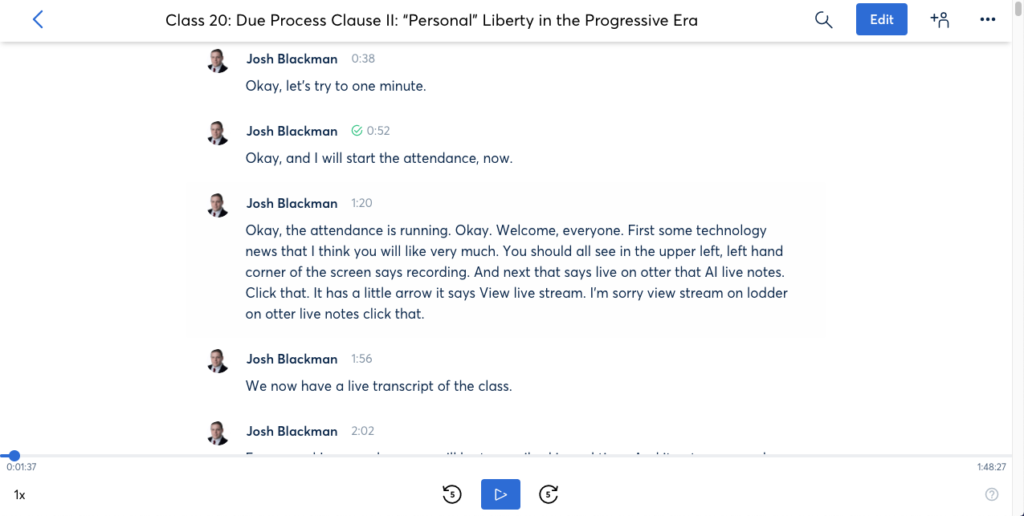The Volokh Conspiracy
Mostly law professors | Sometimes contrarian | Often libertarian | Always independent
A Game Changer for Zoom Classes: Live Transcription by Otter.ai
Otter.ai will automatically add closed-captions to your Zoom screen, and create an interactive transcript in real time.
During class, students will often type everything a professors says. This sort of rote stenography is very, very ineffective. First, students have to focus so hard on capturing every word that they seldom think about what is being said. Second, verbatim notes are usually ineffective. Students do not have time to re-read the entire class from scratch. Third, students in transcription mode may not think of important questions in the moment. The most important element of class is the ability to ask questions.
Many professors have banned laptops, for among other reasons, to force students to take careful handwritten notes. But without a laptop, students may feel that their outlines are lacking. To remedy this deficiency, some professors will appoint a student as the designated note taker for a given class. He or she can use a laptop, and then share notes with the entire class. With this approach, students can still obtain a detailed class outline, but still have time to actually pay attention. I've always been skeptical of this approach. I would never trust someone else to prepare my outline. Not because I do not trust him or her. But because I have a very idiosyncratic way of learning that likely does not fit how others learn.
Since I started teaching in 2012, I have live-streamed all of my classes to YouTube. I've told students they do not need to type everything I say. They can simply fill in gaps in their notes later. This approach has worked well enough.
Now, I've discovered a game-changer. It is possible to automatically transcribe a Zoom call in real-time. Yes. As you speak, closed captions are generated. And, a running transcript is created that students can access during, or after class. The software is known as Otter.AI. And it now interacts with Zoom.
The easiest way to understand how this software works is to review a transcript. Here is a link to my ConLaw class from Wednesday. Click it. I'll wait. Welcome back.
This transcript was generated in real time as the class progressed. Otter can separate when I am speaking, and when a student is speaking. You can quickly search the transcript for key words. And if you click on any part of the transcript, it automatically starts playing the audio. You can also play the audio at different speeds, and even skip the empty spaces with no sound.
My students absolutely loved the technology. First, this system eliminates the need to transcribed lectures verbatim. That was never a good use of the time. Now, students can pay closer attention, without the fear that they will miss something. Second, many students are visual learners. Seeing the words on the screen as I say them reinforces the message. Third, it becomes very easy to review a lecture after class. Students can jump to a specific portion to review what was said. There is no easy way to do this on YouTube, without scrolling around. To that end, I have converted my entire YouTube library to Otter. Now, the entire semester is searchable.
Not every professor will value this tool. Students could use this tool to slack off, and not take any notes. I'm not so concerned. If a student is willing to put minimal effort into their notes, then whatever they are doing now is probably a waste of time. I often review student outlines. The quality varies wildly. I think this sort of technology would free a student from the robo-type mode, and could allow them to pay closer attention. And, in theory, a professor who bans laptops can feel more comfortable that nothing is being missed.
Still, I suspect that some professors will fear the Otter. They will resist this sort of tool if offered. Well, that resistance won't really help. Students can purchase their own Otter accounts for about $10 month. They can run the app on their phones or desktops during class. And create their own outlines. Of course, professors can ban these recordings. But let's be frank: you can't stop the signal. So embrace the signal.
The professional plan costs $30 a month, and allows you to transcribe up to 100 hours of content a month. The configuration process is straightforward. It took me about 10 minutes to set up. My IT Department was gracious enough to give me access to the cloud server recording settings. Not everyone may get those privileges. But colleges should look into this system.
If you have any questions, please email me. I'm happy to provide any feedback or assistance.





Show Comments (18)